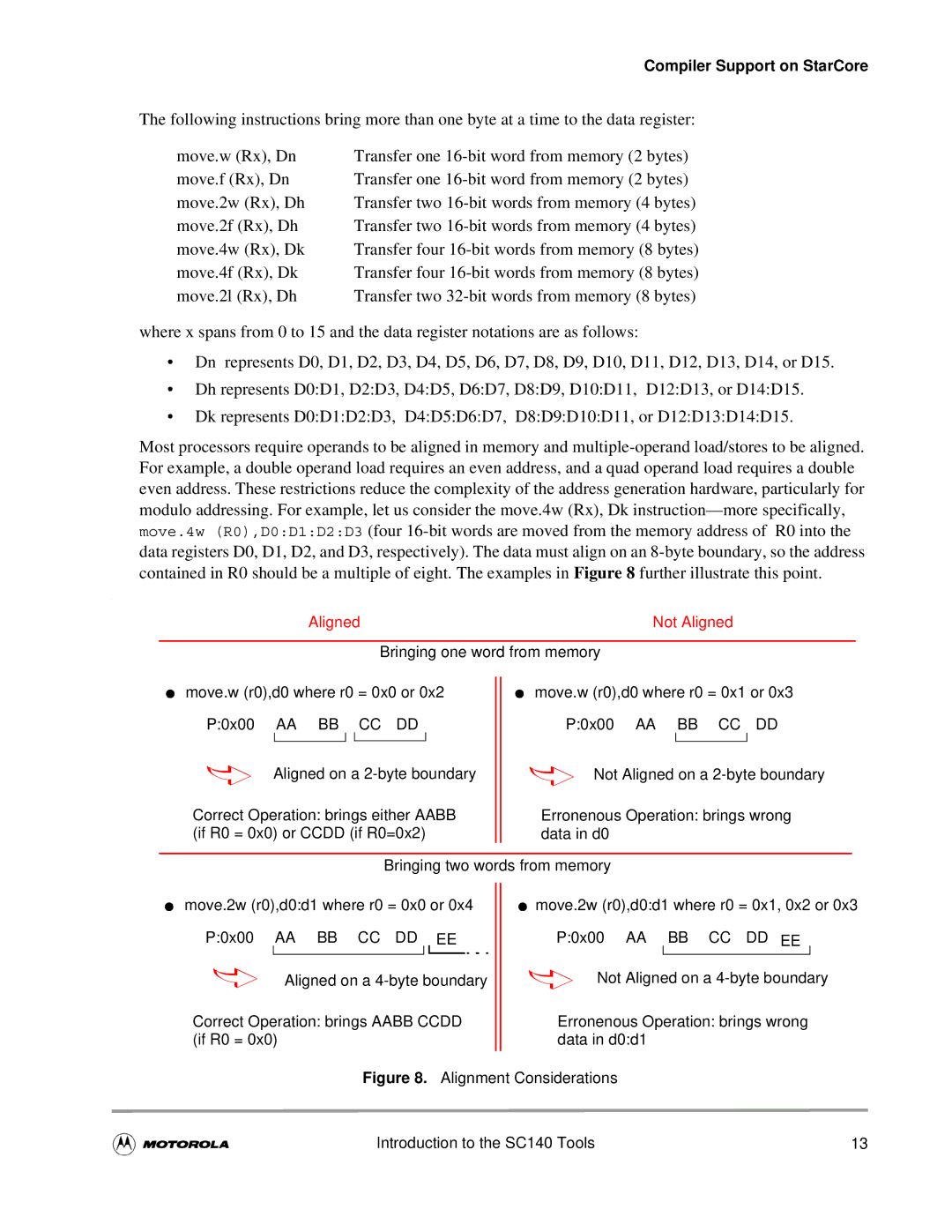
Compiler Support on StarCore
The following instructions bring more than one byte at a time to the data register:
move.w (Rx), Dn move.f (Rx), Dn move.2w (Rx), Dh move.2f (Rx), Dh move.4w (Rx), Dk move.4f (Rx), Dk move.2l (Rx), Dh
Transfer one
where x spans from 0 to 15 and the data register notations are as follows:
•Dn represents D0, D1, D2, D3, D4, D5, D6, D7, D8, D9, D10, D11, D12, D13, D14, or D15.
•Dh represents D0:D1, D2:D3, D4:D5, D6:D7, D8:D9, D10:D11, D12:D13, or D14:D15.
•Dk represents D0:D1:D2:D3, D4:D5:D6:D7, D8:D9:D10:D11, or D12:D13:D14:D15.
Most processors require operands to be aligned in memory and
.
|
|
|
|
|
|
|
|
| Aligned |
|
|
|
|
|
|
|
|
| Not Aligned |
|
|
|
|
| ||||||||
|
|
|
|
|
|
|
|
|
|
|
|
|
|
|
|
|
|
|
|
|
|
|
|
|
|
|
|
|
|
|
| |
|
|
|
|
|
|
|
|
|
|
| Bringing one word from memory |
|
|
|
|
|
|
|
|
|
| |||||||||||
move.w (r0),d0 where r0 = 0x0 or 0x2 |
| move.w (r0),d0 where r0 = 0x1 or 0x3 | ||||||||||||||||||||||||||||||
| ||||||||||||||||||||||||||||||||
P:0x00 AA BB CC DD |
|
|
|
|
|
|
|
| P:0x00 | AA |
|
| BB | CC | DD | |||||||||||||||||
|
|
|
|
|
|
|
|
|
|
|
|
|
|
|
|
|
|
|
|
|
|
|
|
|
|
|
|
| ||||
|
|
|
|
|
|
|
| Aligned on a |
|
|
|
|
| Not Aligned on a | ||||||||||||||||||
|
|
|
|
|
|
|
|
|
|
|
|
| ||||||||||||||||||||
Correct Operation: brings either AABB |
| Erronenous Operation: brings wrong | ||||||||||||||||||||||||||||||
(if R0 = 0x0) or CCDD (if R0=0x2) |
|
|
|
| data in d0 |
|
|
|
|
|
|
|
|
|
| |||||||||||||||||
|
|
|
|
|
|
|
|
|
|
|
|
|
|
|
|
|
|
|
|
|
|
|
|
|
|
| ||||||
|
|
|
|
|
|
|
|
|
|
| Bringing two words from memory |
|
|
|
|
|
|
|
|
|
| |||||||||||
move.2w (r0),d0:d1 where r0 = 0x0 or 0x4 |
| move.2w (r0),d0:d1 where r0 = 0x1, 0x2 or 0x3 | ||||||||||||||||||||||||||||||
| ||||||||||||||||||||||||||||||||
P:0x00 |
| AA BB CC DD |
|
|
| EE |
|
|
|
|
|
| P:0x00 | AA |
| BB | CC | DD EE |
|
|
| |||||||||||
|
|
|
|
|
|
|
|
| Aligned on a |
|
|
|
|
| Not Aligned on a | |||||||||||||||||
|
|
|
|
|
|
|
|
|
|
|
|
|
| |||||||||||||||||||
Correct Operation: brings AABB CCDD |
|
|
|
|
| Erronenous Operation: brings wrong | ||||||||||||||||||||||||||
(if R0 = 0x0) |
|
|
|
|
|
|
|
| data in d0:d1 |
|
|
|
|
|
|
|
|
| ||||||||||||||
|
|
|
|
|
|
|
|
|
|
| Figure 8. |
| Alignment Considerations |
|
|
|
|
|
|
|
|
|
| |||||||||
|
|
|
|
|
|
|
|
|
|
| Introduction to the SC140 Tools |
|
|
|
|
| 13 | |||||||||||||||
